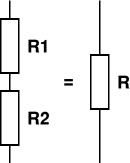
Resistance | In Series | In Parallel | Conductors & Insulators
Next Page: Ohm's Law
Also See: Resistors | Impedance
Resistance is the property of a component which restricts the flow of charge. Energy is used up as the voltage across the component drives current through it and this energy appears as heat in the component.
Resistance is measured in ohms, the symbol for ohm is an omega Ω.
1 Ω is quite small for electronics so resistances are often given in kΩ and MΩ.
1 kΩ
= 1000 Ω
1 MΩ
= 1000000 Ω.
Resistors used in electronics can have resistances as low as 0.1Ω or as high as 10MΩ.
Rapid Electronics: Resistors

When resistors are connected in series their combined resistance is equal to the individual resistances added together. For example if resistors R1 and R2 are connected in series their combined resistance, R, is given by:
| Two resistors in series: | R = R1 + R2 |
This can be extended for more resistors:
| Resistors in series: |
R = R1 + R2 + R3 + R4 + ... |
The combined resistance in series will always be greater than any of the individual resistances.

When resistors are connected in parallel their combined resistance is less than any of the individual resistances.
There is a special equation for the combined resistance of two resistors R1 and R2 in parallel:
| Two resistors in parallel: | R = | R1 × R2 |
| R1 + R2 |
For more than two resistors connected in parallel a more difficult equation must be used. This adds up the reciprocal ('one over') of each resistance to give the reciprocal of the combined resistance, R:
| Resistors in parallel: | 1 | = | 1 | + | 1 | + | 1 | + ... |
| R | R1 | R2 | R3 |
The simpler equation for two resistors in parallel is much easier to use!
The combined resistance in parallel will always be less than any of the individual resistances.
The resistance of an object depends on its shape and the material from which it is made. For a given material, objects with a smaller cross-section or longer length will have a greater resistance.
Materials can be divided into three groups:
Examples include metals (aluminium, copper, silver etc.) and carbon. Metals are used to make connecting wires, switch contacts and lamp filaments. Resistors are made from carbon or long coils of thin wire.
Examples include germanium and silicon. Semiconductors are used to make diodes, LEDs, transistors and integrated circuits (chips).
Examples include most plastics such as polythene and PVC (polyvinyl chloride), paper, wood, rubber and glass. PVC is used as an outer covering for wires to prevent them making contact.